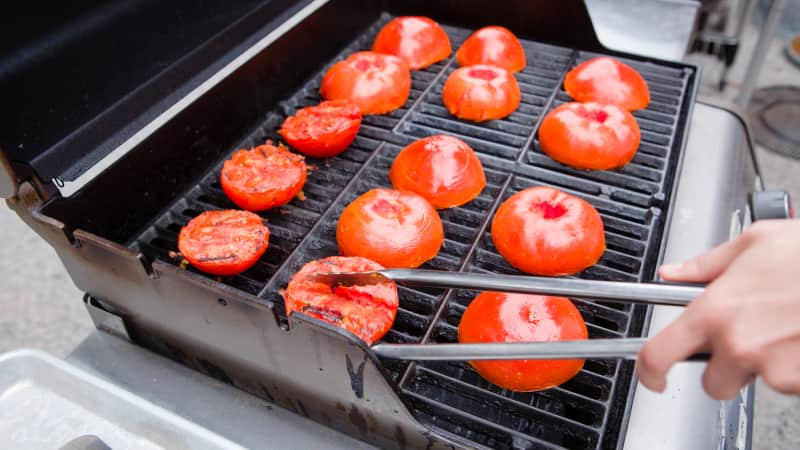My Goals
- Tomatoes hold their shape on the grill
- Tomato flesh stays intact
- Tomatoes get caramelization and char from the grill
Published May 30, 2018.

Here’s an idea for showcasing summer tomatoes that you may not have considered: Grill them. A stint over a hot fire softens the fruit’s flesh and concentrates its sweetness.
Meanwhile, the smoky char of the grill adds another dimension of flavor. If that’s not enough to grab your attention, consider this: Tomatoes cook quickly, so you can grill them while your steak or other protein is resting and the coals are still hot.
For my first attempt, I used the easiest approach I could think of: simply placing 2 pounds of whole tomatoes on the grill. But by the time the fruit had sufficiently charred on the exterior, it was starting to turn mushy and disintegrate within. Plus, the interior didn’t pick up any grill flavor to speak of.

It worked better to cut the tomatoes in half so that both the interiors and the exteriors could spend some time in contact with the grill grate. This way, there was lots of surface area available to quickly caramelize and char before the flesh started to break down too much. I also found that ripe but still firm tomatoes held their shape best during and after grilling—supersquishy ones fell apart. What’s more, the way the tomatoes were cut had a huge impact on the results: It was essential to halve them along their equators, not pole to pole. Cut this way, the tomatoes stayed intact even as they began to soften.
How you halve a tomato affects how well it will hold its shape during grilling. Cutting it pole to pole leaves intact seed pockets that will burst when heated, causing the tomato to slump. However, cutting it along the equator slashes the seed pockets so that moisture can escape and the tomato stays intact.
While the grill heated up—which took about 15 minutes—I sprinkled the raw tomato halves with salt and pepper and drizzled them with extra-virgin olive oil. Almost immediately, the salt began to draw liquid from the tomato flesh via osmosis, which is just what I wanted. The drier the tomatoes were, the more easily caramelization could occur.
Leaving the tomato liquid in the bowl, I placed the tomatoes skin side down on the grill. After a few minutes, I flipped them—only to have warmed seeds and liquid flood the coals. The next time around, I grilled the halves cut side down for about 5 minutes and then flipped them skin side down and cooked them roughly 5 minutes longer. With this approach, the skins acted as cradles during the second half of cooking, helping contain the flesh as it continued to soften.
When the skins were adequately charred and the juices were bubbling, I pulled the tomatoes off the grill. They tasted sweet and savory, with a light smokiness, but they lacked a bit of brightness. I realized that the liquid shed during the salting step was loaded with fresh, raw tomato flavor, so I drizzled it onto the grilled halves. The fresh tomato juice captured the true essence of summer and beautifully complemented the richer taste of the grilled flesh. These tomatoes were great for just about anything, including pasta, sandwiches, salads, soups, and sauces. To show off their versatility even further, I developed a simple grilled tomato salsa with onion, jalapeño, cilantro, and lime juice, as well as a marinated mixture of fresh mozzarella cheese and the tomatoes. And for a deeply flavorful twist on gazpacho, I pureed the tomatoes with cucumber, aromatics, olive oil, vinegar, and a slice of bread for body.
For the recipes in which the tomatoes were chopped, I initially slipped off the skins since their texture was distracting. But because some of the smokiness of the grill does transfer to the skins, discarding them meant discarding smoky flavor. It worked much better to chop the skins separately and include them. This way, their flavor could permeate the dish without their texture being bothersome.

These tomatoes are so full-flavored and versatile that I plan on making them all summer long.
Tomatoes hold their shape on the grill
Cutting the tomatoes along their equators rather than pole to pole and using ripe but firm tomatoes ensures that they hold their shape during and after cooking.
Tomato flesh stays intact
Grilling the tomatoes cut side down first means the skin acts like a cradle to hold the tomatoes together as they continue to soften.
Tomatoes get caramelization and char from the grill
Cutting the tomatoes in half allows both the interiors and the exteriors to make contact with the grill for more char flavor. Salting the tomatoes ahead allows some of their juice to be drawn out, so they'll be less wet and pick up better browning.

This is a members' feature.